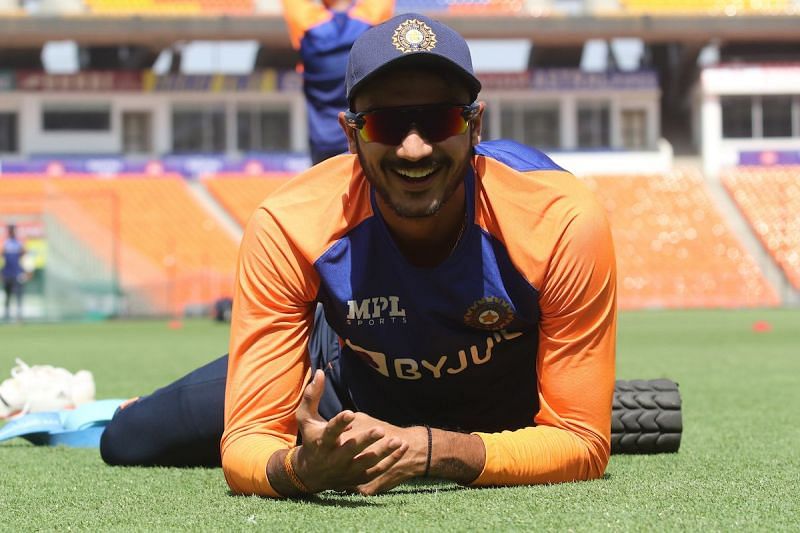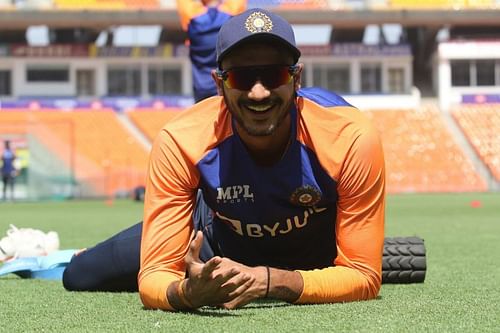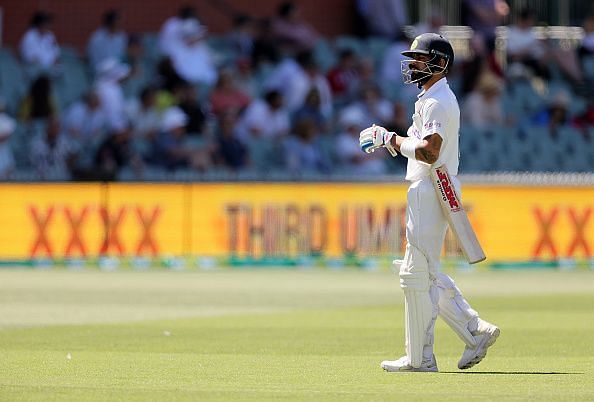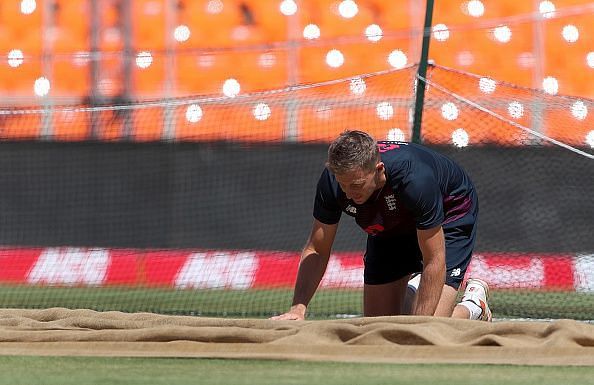
"You must appreciate Axar for the way he has gone about his business" - Venkatapathi Raju [Exclusive]

There's a lot of attention being given to the pitch in the on-going series between India and England, the fourth Test of which begins on Thursday in Ahmedabad. With the home team harbouring hopes of retaining the Anthony de Mello Trophy, one cannot help but recall the 1993 Test series in India between the two countries. The Indian team asked for rank-turners in that series to drub England, which they eventually did, 3-0. India ‘brownwashed’ England in that series.
Of course, there have been many other series before and after in which the Indian spinners, and to some extent England’s, have dominated. England have lost 49 of their wickets so far to spinners and the remaining 11 to speedsters.
Ravichandran Ashwin (24 wickets) and Axar Patel (18) have dominated like nobody else, sharing 42 out of 60 England wickets in the first three Tests of the current rubber. Other spinners in Shahbaz Nadeem (4), Kuldeep Yadav (2) and Washington Sundar (1) have also had some pieces of the cake, while medium-pacers Ishant Sharma (6), Jasprit Bumrah (4) and Md Siraj (1) too have shared the spoils.
This is somewhat similar to what the spin trio of leg-spinner Anil Kumble (21 wickets), left-arm spinner Venkatapathi Raju (16) and off-spinner Rajesh Chauhan (9) achieved to guide India to a 3-0 drubbing of England.
Raju, who has donned many hats since his playing days, including a stint as the national selector around the time India won the inaugural World T20 title in 2007 also had quite a few years in coaching associate nations in his capacity as development officer with the Asian Cricket Council. Also a member of the coaching team for ICC Americas Cricket Combine, Raju shared his insights into the success of fellow left-arm spinner Axar Patel, who has taken a five-wicket haul in each of his first two Tests.
Raju, who played in 28 Tests and 53 ODIs between 1990 and 2001 to take a combined tally of 156 international wickets (93 in Tests and 63 in ODIs), said that he was not surprised at all by the manner in which Patel in particular has picked up his wickets.
“You must appreciate Axar for the way he has gone about his business,” Raju told Sportskeeda in an exclusive chat on Wednesday. “He is a tall guy and has waited for his chances. He has been playing Ranji Trophy and is used to bowling long spells.”
Axar played in 39 First-Class matches and picked up 134 wickets before making his Test debut in the second Test of the series in Chennai. The current series is not Patel’s maiden international experience. He was a regular in the limited-overs format between 2014 and 2017, playing in 38 ODIs and 11 T20Is for a combined tally of 54 scalps. Raju said that today’s players are ready to grab the opportunity with both hands whenever it arises.
“People should be ready to play all formats. In the present day, everything has changed. He himself has admitted that he doesn’t get wickets and wants to keep his end tight. Height is an advantage that he has made the most use of now-a-days. Anyone who gets an opportunity wants to cement his place in the Indian team. That’s what Axar has done.”
The 51-year-old from Hyderabad, currently in Mumbai as a Telugu commentator for the host broadcasters, added -
“Axar has played most of his cricket in Ahmedabad on similar pitches (like the ones presented for the second and third Tests). He is quite experienced playing for so long.”
The talk of the Ahmedabad resulting in a two-day Test has taken the sheen off the individual performances. Having shown what Patel is capable of, it will be a tricky situation once Ravindra Jadeja is fully fit and available for selection in the next Test series. However, Raju said that Patel should not be worried about his place.
“The Indian team has more options. Jadeja has been doing a brilliant job as an all-rounder. But Axar should be ready when the call comes if someone is injured, like he was for the current series.”
"Important to cope with challenges" - Venkatapathi Raju

Raju further said that global cricket has changed so much, and with so much cricket being played in recent times, players are always ready for the challenge. It is just that the players have to adapt, he added.
“Times have changed. According to that, players are adjusting. There were no sweeps or revere sweeps until (Zimbabwe’s) Andy Flower did it in India in the 1990s. There was no pad play as umpires gave you out deliberately padding until (West Indies’s) Jimmy Adams did and padded his way to glory in India in the 1990s. He used it to his advantage. It is how you cope up with the challenges.”
Also speaking of changing times, the visiting teams played in tour games to get used to the conditions before and during Test series in the earlier days. Raju said that even the Indian players who were not in form were sent to play in those tour games like the visiting team against Board President’s XI, Ranji Trophy champions or zonal teams, to help them get back into form.
“In the 1980s and 1990s, there were no T20s. There were not these many games of international cricket. There were tour games for the visiting teams. In 1998, Ranji champions Mumbai played a full strength team against Australia and Sachin Tendulkar got a double hundred. Before the 1993 series against England, Navjot Singh Sidhu played for Board President’s XI against England. The amount of thrashing he gave England spinners Phil Tufnell and John Emburey had a big impact on the whole series. That liberty is not there now-a-days”.
Raju suggested that with the pink-ball being a regular feature in every Test series, the Indian players who will be part of that day-night Test should play in domestic matches to prepare, similar to the Ranji Trophy versus Rest of India games.
“If you look at it, our Indian players don’t have that much experience playing the pink ball. It started with experimenting in Duleep Trophy a few seasons ago. The league matches were day games and when the final was played under lights, a lot of the players complained about not being able to see the seam of the ball as it was black in colour."
"This time (in the Test series), they tried with SG ball. None of them have not played much with pink ball. If pink ball cricket is going to be a feature in every series, then play Ranji Trophy champions vs Rest of India when the players are available. This can be a part of the preparation so that players going to be a part of pink-ball Test get a hang of it. The preparation for pink ball Test is different”.
Venkatapathi Raju feels pitches are given "too much importance"

Raju admitted that the home team in those days had the advantage as pitches were turners. As for the current day, he did express his surprise as to all the noise that's surrounding conversations around the current state of pitches in India.
“In the current series, nobody got hit on the glove. They were out LBW or getting caught at slips. It was not a pitch where the ball was hitting your chest, glove or head. Earlier this year in Adelaide, India were bowled out for 36. The match ended in three days. Nobody spoke about the pitch. In New Zealand last year when India toured, New Zealand prepared pitches to their liking and Tests ended in three days. Nobody complained then."
“New Zealand would not have been part of the World Test Championship final if they did not make pitches the way they wanted. They took a chance. Win or lose or draw would not have mattered to them. They took a chance. Nobody complained then. We give too much importance to pitches."
Being so modest about not blowing his own trumpet, Raju said the toss was vital in the 1993 home series against England.
“It was red ball cricket and toss was so vital. The England batsmen got some big hundreds in that series. (Captain) Md Azharuddin got 182 in Kolkata, Sachin Tendulkar 165 in Chennai, Graeme Hick 178 in Mumbai. There was no T20 then, so batsmen played for long. Home side had the advantage as most of them were turners. Now-a-days, with too many T20s, batsmen tend to play more shots. You feel dot balls are not good. You cultivate a shot.”
With India having taken an unassailable 2-1 lead in the 4-match Test series, the hosts will go into the final match brimming with confidence. One can be rest assured that if the pitch's behaviour turns out to be even a little similar to the one that was on show in the third Test, India have a good chance of picking up another win on home soil.